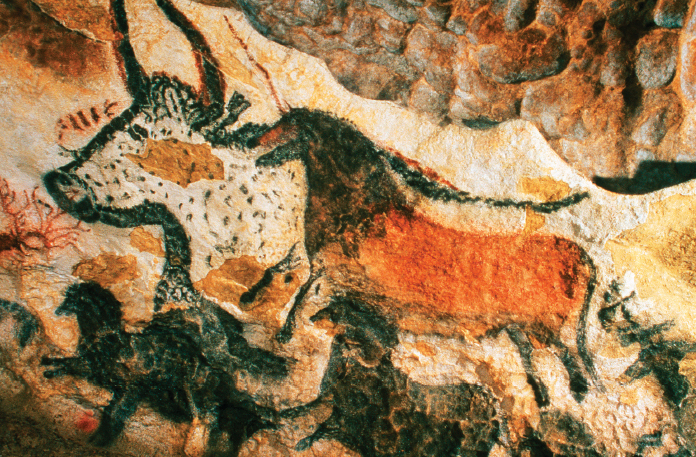Understanding World Societies:
Printed Page 15
Cultural Creations and Spirituality

This flute, carved from the wing bone of a griffon vulture, was unearthed in a cave in Germany along with pieces of other flutes made from mammoth ivory and stone tools. Dating from at least 33,000 B.C.E., it is the oldest musical instrument ever found and suggests that music has long been an important part of human culture. (H. Jensen/University of Tübingen)
Beginning in the Paleolithic, human beings expressed themselves through what we would now term the arts or culture: painting and decorating walls and objects, making music with their voices and a variety of instruments, imagining and telling stories, dancing alone or in groups. Evidence from the Paleolithic, particularly from after about 50,000 years ago, includes flutes, carvings, jewelry, and paintings done on cave walls and rock outcroppings that depict animals, people, and symbols.
At the same time that people marked and depicted the world around them, they also appear to have developed ideas about supernatural forces that controlled some aspects of the natural world and the place of humans in it, what we now term spirituality or religion. Paleolithic burials, paintings, and objects suggest that people may have thought of their world as extending beyond the visible. People, animals, plants, natural occurrences, and other things around them had spirits, an idea called animism. The only evidence of Paleolithic animism that survives is physical, of course, but more recent animist traditions carry on this understanding of the spiritual nature and interdependence of all things.
Death took people from the realm of the living, but for Paleolithic groups people continued to inhabit an unseen world, along with spirits and deities, after death; thus kin groups included deceased as well as living members of a family. The unseen world regularly intervened in the visible world, for good and ill, and the actions of dead ancestors, spirits, and gods could be shaped by living people. Concepts of the supernatural pervaded all aspects of life; hunting, birth, death, and natural occurrences such as eclipses, comets, and rainbows all had religious meaning. Supernatural forces were understood to determine the basic rules for human existence, and upsetting these rules could lead to chaos.

The artist who made these amazing animals in charcoal and red ochre first smoothed the surface, just as a contemporary artist might. This cave includes paintings of hundreds of animals, including predators such as lions, as well as abstract symbols. (JM Labat/Photo Researchers, Inc.)> PICTURING THE PASTANALYZING THE IMAGE: The artist painted the animals so close together that they overlap. What might this arrangement have been trying to depict or convey?CONNECTIONS: Why might Paleolithic people have made cave paintings? What do these paintings suggest about Stone Age culture and society?
Ordinary people learned about the unseen world through dreams and portents, and messages and revelations were also sent more regularly to shamans, spiritually adept men and women who communicated with the unseen world. Shamans created complex rituals through which they sought to ensure the health and prosperity of an individual, family, or group. Objects understood to have special power, such as carvings or masks in the form of an animal or person, could give additional protection, as could certain plants or mixtures eaten, sniffed, or rubbed on the skin. Shamans thus also operated as healers, with cures that included what we would term natural medicines and religious healing.
>QUICK REVIEW
What social relationships shaped and defined Paleolithic bands?